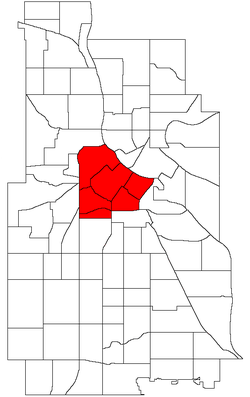Central | |
|---|---|
 Location of Central Minneapolis in Minneapolis | |
| Country | United States |
| State | Minnesota |
| County | Hennepin |
| City | Minneapolis |
| Founded | 1849 |
| City Council Wards | 3, 5, 6, 7 |
| Neighborhoods | |
| Government | |
| • Council Member | Michael Rainville |
| • Council Member | Jeremiah Ellison |
| • Council Member | Jamal Osman |
| • Council Member | Katie Cashman |
| Area | |
• Total | 3.024 sq mi (7.83 km2) |
| Population (2023) [2] | |
• Total | 60,549 [3] |
| • Density | 19,315/sq mi (7,458/km2) |
| Time zone | UTC-6 (CST) |
| • Summer (DST) | UTC-5 (CDT) |
| ZIP Code | 55401, 55402, 55403, 55404, 55405, 55411, 55415, 55454, 55487 |
| Area code | 612 |
| Census | Pop. | Note | %± |
|---|---|---|---|
| 1980 | 18,952 | — | |
| 1990 | 21,158 | 11.6% | |
| 2000 | 24,149 | 14.1% | |
| 2010 | 29,725 | 23.1% | |
| 2020 | 53,093 | 78.6% | |
| 2024 (est.) | 60,549 | [3] | 14.0% |

Central is a defined community in Minneapolis that consists of six smaller official neighborhoods around the downtown and central business core. It also includes the many old flour mills, the Mill District, and other historical and industrial areas of downtown Minneapolis. It also includes some high-density residential areas surrounding it, excluding areas east of the Mississippi River. Businesses and government buildings are based in the Central area include the corporate headquarters of the Star Tribune , Target, US Bancorp, the Hennepin County Government Center, Minneapolis Central Library, Minneapolis City Hall, and the broadcast facilities of the Minnesota CBS station WCCO-TV.
Contents
There is no City Council ward representing the majority of Central Minneapolis. It is split between Wards 3, 5, 6, and 7, [4] represented by Council Members Rainville, Ellison, Osman, and Cashman respectively.


















